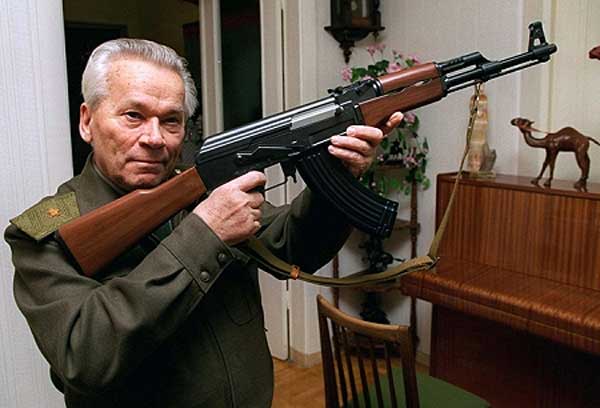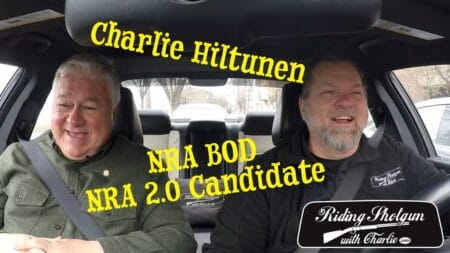THE GUN by C.J. Chivers
History of the Kalashnikov Rifle or AK-47

“…eye-opening…it‘s hard to resist a narrative that ends with a world awash with a weapon that has killed more soldiers and civilians than all the high-tech planes, missiles, bombs, WMDs and America‘s sophisticated rifles combined. An entertaining work that combines technical details, biographies, political maneuvering and insightful military history.” –Kirkus Reviews
The Gun is a model of research, historical writing, military expertise, and a soldier‘s ungrudging respect for a weapon that really works.? –Thomas Powers, author of Intelligence Wars
“This superior history….[is] written incisively and researched exhaustively.”–Booklist
“The Gun does exactly what the best art history or music writing does—it opens our eyes to see anew the familiar. Chivers’ reach and scope is syncretic, omnivorous—he is dazzling in his research and reporting. This is a book about connections between people and culture, people and history, nations with nations. Chivers pulls together vast threads of an expanding portrait and what emerges is startling. The Gun is filled with a sense of discovery in the way that John McPhee‘s work is filled with delight, tribulation, and surprise.” –Doug Stanton, author of Horse Soldiers
“The Gun is for those who wonder how we fight today and why we fight that way. C. J. Chivers has given us a seminal work that will be respected by future generations trying to understand us.” –James Bradley, author of Flags of Our Fathers, Fly Boys, and The Imperial Cruise

Roseburg, OR –-(Ammoland.com)- It is the most notorious, widespread, and lethal firearm in the world.
Created in the Soviet Union at the start of the Cold War, the automatic Kalashnikov rifle, or AK-47, as it was first called, was a breakthrough weapon – a cheap, simple, and reliable device that allowed ordinary men to kill other men without extensive training or undue complication.
It was used to crush anticommunist uprisings in Eastern Europe, to battle American troops in Vietnam (who found it far superior to the early versions of their own M-16s), and as a symbolic statement by Osama bin Laden in his first taped message after the attacks of September 11, 2001. Today it remains a leading cause of battlefield deaths for American soldiers in Afghanistan and Iraq, and terrorist-training records show that an introduction to the Kalashnikov is often to be the first class given to the young Islamic men who sign on for the Jihad.
In THE GUN (Simon & Schuster; October 12, 2010; $28.00), Pulitzer Prize-winning New York Times reporter and former Marine infantry officer C. J. Chivers presents a rich, engrossing, and comprehensive narrative history of this ground-breaking weapon – not only as a killing tool but as a strategic and political instrument that has changed the rules of war and influenced security and development in large sections of the world. Some six decades after its invention, the armies of more than fifty countries employ the Kalashnikov, as do myriad police, intelligence, and security agencies. But by design and by accident, it has long since passed beyond the control of governments. Authoritative estimates place the number of Kalashnikovs and their knockoffs as high as 100 million – one for every seventy people alive. It is now an everyman‘s gun that marks the terrorist, the guerrilla, the child soldier, the dictator, the drug trafficker, and the thug as much as the professional soldier.

THE GUN is a well-organized and fast-moving narrative that operates at several levels. At the most basic level, Chivers focuses on the original AK-47 and its many derivatives and companion firearms that have flooded armories and arms bazaars around the world. He examines their origins, design, production, distribution, stockpiling, export, and use as one of the predominant instruments of war of the past half-century – a status they are likely to retain for at least a half- century more. But he seeks a larger context, and to equip the reader with a full understanding of how war has evolved and where the assault rifle fits, he traces the development of automatic weapons from the American Civil War through two world wars, the Cold War, and Vietnam to the present day. Chivers shows how the Kalashnikov became the product of evolutionary processes in firearms and ammunition development and changes in military and economic thinking that accompanied an industrializing and polarizing world. But this is not merely the story of a weapon and where it came from. It is a chronicle of how war has changed, a rich work of history and a journey populated by geniuses and fools, ruthless villains and naïve idealists, self-promoting salesmen and incorrigible profiteers, a pantheon of killers of all stripes and, now and then, people who wanted the killing to stop. The book‘s vivid and rigorously reported character sketches – of expeditionary military leaders in the lopsided colonial fighting in nineteenth-century Africa; of a famed arms designer who was a trigamist and apparent draft dodger; of Winston Churchill reacting in horror to industrialized war along the Nile; of the treacherous lives of officials in Stalin‘s Soviet Union; of the first known guerrilla to carry a Kalashnikov in an uprising, in Hungary in 1956; of an enraged young Marine officer who stakes his name and his career in an act of conscience; of a bodyguard shot by Iraqi assassins 23 times at close range – make THE GUN a feat of storytelling, and elevate the story of the AK-47 to an engaging history.
What is this rifle? At first glance, the new AK-47 was an oddity, a rifle deviating from the classic forms in many ways. A midsized weapon that fired a medium-sized cartridge, it was not powerful enough for long-range sniping duty, but it could push out blistering automatic fire for the length of two or three football fields. As American Marines found in Vietnam, a single guerrilla with a Kalashnikov could slow an entire company‘s advance. It was so reliable, even when soaked in water and coated with sand, that its Soviet testers had trouble making it jam. It was so simple that it could be disassembled and reassembled by schoolboys in less than thirty seconds flat. Weighing less than ten pounds and easily concealed, it was an eminently well-conceived killing tool, which could be easily wielded with efficiency even by the small of stature, the mechanically disinclined, the dimwitted, or the untrained.
Stalin’s Contest: The Invention of the AK-47
Drawing on years of research, a trove of exclusive sources, and declassified documents from both the West and the East – as well as on battlefield reportage and interviews with revolutionaries, terrorists, child soldiers, arms dealers, conventional grunts, and Mikhail Timofeyovich Kalashnikov, the man credited with the weapon‘s design – Chivers travels the world, establishes a firm historical record, and demolishes many myths about the AK-47. Legend claims that it was born out of an epiphany at the workbench of a Russian sergeant, Mikhail Kalashnikov, who was competing in a weapon design contest in Stalin‘s Soviet Union. In fact, the acronym AK-47 abbreviates two Russian words, avtomat kalashnikova (Kalashnikov‘s automatic), which pays tribute to this proletarian hero of Soviet propaganda. The numerals signify the year the Soviet army accepted the prototype for mass production.
But as Chivers shows, the political, military, and industrial system of the Soviet state was the real inventor – both of the AK-47 and its fables. Chivers also reveals how the United States, the incubator for rapid-fire arms in the nineteenth century, repeatedly misread the path of automatic arms development in the twentieth, leaving American soldiers and Marines badly outgunned by the 1960s. The Vietnam chapter is rooted in ground-breaking reporting and research that reveals the fullest story ever documented of the debacle of the Pentagon‘s introduction of the M-16 (a hurried reaction to the AK-47). The chapter uncovers sham science and official embarrassment and folly, including secret U.S. Army –lethality? tests against decapitated human heads and severed human legs from India. The tests had been covered up for almost five decades. The chapter also reveals internal memos and correspondence from the manufacturer, as well as secret Pentagon correspondence, showing that the men who pushed the early M-16 into service knew it was a faulty weapon that needed to be reworked, and yet sent the rifles to Vietnam nonetheless and kept quiet about their choices as the rifles failed in the hands of G.I.s.
Chivers rejects all myths, and resists repeating the received wisdom surrounding the world‘s most visible and abundant firearm. He explains how the Kalashnikov became the most important line of firearms in history not simply because they work well and are easy to handle, but because Warsaw Pact military standardization mandates and their production in planned economies assured they were manufactured in outsized quantities. As its numbers grew and reputation spread, and as the Kremlin and the White House realized that their stockpiles of nuclear weapons had made total war unwinnable, Stalin‘s rifle became the defining weapon of the Cold War. Small wars and proxies would be the means through which the Cold War would be fought – and the automatic Kalashnikov would be the perfect weapon with which to fight it. –The Kalashnikov Era had arrived,? Chivers writes. –We are living in it still.?
Everyman’s Gun
With its stubby black barrel, dull brown stock, and distinctive banana clip, the Kalashnikov is the most recognized weapon in the world. It has been used prolifically not only in armed clashes but also in political art and ritual displays. More than a weapon, it has also become a symbol – first of the industrial success of Stalin‘s Soviet Union and the socialist way, later of popular insurrection, armed liberation, gangland stature, and most recently of jihad. Kalashnikovs guard South American coca plantations, serve urban gangs in Los Angeles, are hoarded by survivalists in the northwestern United States, and have been used by ivory poachers to nearly exterminate elephant herds in Africa.
As Chivers observes, in the aftermath of the Cold War, the overabundance of AK-47s has remained a persistent factor in terrorism, crime, ethnic cleansing, and local and regional destabilization. The weapon‘s ubiquitous presence empowers undisciplined forces to commit human rights abuses on a grander scale, raises the costs and exacerbates the dangers of peacekeeping missions, emboldens criminals of many sorts, stalls economic development, and increases the social burdens of caring for the wounded, the orphaned, and the displaced. Shipped by the millions to regions rife with the tensions of poverty, poor government, and high ethnic, religious, or nationalist sentiment, the AK-47 has helped to instigate and expand conflicts.
Ominously, specialists in armed conflict look to the price of Kalashnikovs in a nation‘s open-market arms bazaars to determine the state of risk. When prices rise, public anxiety is considered high. When they sink, the decline can indicate a conflict is ebbing. Chivers, a veteran of combat zones around the globe as both reporter and Marine, writes, –Anywhere large numbers of young men in civilian clothes or mismatched uniforms are carrying Kalashnikovs is a very good place not to go; when Kalashnikovs turn up in the hands of mobs, it is time to leave.? The Twenty-first Century’s Rifle
The AK-47 is a Cold War weapon with a legacy as yet unresolved, a legacy that continues to threaten people and security across much of the world. Chivers proposes that because governments have focused elsewhere, Kalashnikovs and the people who have put them to ill use have killed and maimed more people, and dragged many regions deeper into disarray, than they might have otherwise. He looks at certain programs that have met with limited success in ameliorating the effects of assault rifle proliferation. But, unaligned with any interest group or side, he leaves the question of the best means of relief and abatement – of methods that might bring a degree of peace and stability to many troubled lands – to other hands.
With THE GUN, award-winning reporter C. J. Chivers gives us a gripping, exhaustively researched, and far- reaching assessment of the most important weapon of our time. It is sure to be of intense interest to readers fascinated by military and international affairs, the history of firearms, the legacy of the Soviet Union, the evolution of modern warfare, or of a well-told tale that furthers an understanding of the world today. And with its probing historical analysis, vivid reportage, and provocative moral dimension, it will be equally compelling to those concerned with the origins, dynamics, and resolution of global conflict. –Far too many people regard the study of weapons as an illiberal art,? Chivers writes. –The chronicle of automatic firepower, viewed through the AK-47 and its infiltration across the world, suggests otherwise.?
About the Author
C. J. Chivers is a senior writer for The New York Times and its former Moscow Bureau Chief, as well as a frequent contributor to Esquire. From 1988 to 1994, he was an infantry officer in the U.S. Marine Corps, and served in the Gulf War and in the Los Angeles riots before being honorably discharged as a captain. His work has received several prizes, including a National Magazine Award for Reporting for the reconstruction in Esquire of the terrorist siege in Beslan and a shared Pulitzer Prize for International Reporting for coverage in the Times of combat in Afghanistan. His war reportage from 2003 to 2009 in Iraq and Afghanistan was selected by New York University as being among the Top Ten Works of Journalism of the Decade in the United States. He lives with his family in Rhode Island.
More Praise for THE GUN
- C.J. Chivers, a brilliant war correspondent, is an equally capable military historian. By telling the story of a gun–well, not just any gun but arguably ?the‘ gun–he reveals much about crime, war, and terror, and he does so in convincing and compelling fashion.?
- Evan Thomas, author of The War Lovers
- Thanks to C. J. Chivers, every G.I. and Marine in Vietnam who threw down his jammed M-16 in despair can trace the development of the better weapon he envied. The Gun is part a biography of Mikhail Kalashnikov and his AK-47, part grim social history and, in all its parts, entirely absorbing.?
- A. J. Langguth, Our Vietnam: The War 1954-1975
- C. J. Chivers tells a remarkable story of how this one, superbly reliable firearm became the most abundant ever produced, and was to exceed the consequences even of Soviet nuclear know-how in the Cold War, and beyond.?
- Alistair Horne, author of The Price of Glory and A Savage War of Peace
About the Book
THE GUNBy C. J. Chivers
Published by Simon & Schuster
Publication Date: October 12, 2010
Price: $28.00
ISBN-10: 0-7432-7076-2
ISBN-13: 978-0-7432-7076-2
eBook ISBN-13: 1-4391-9653-2; eBook ISBN-10: 1-4391-9653-2






